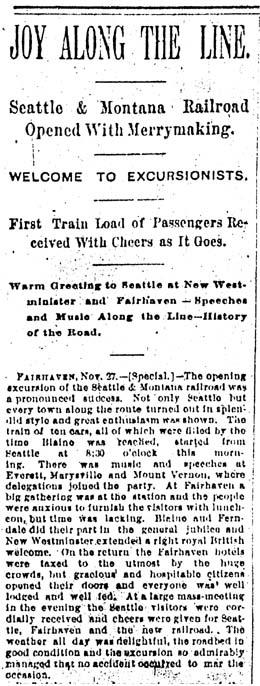On October 12, 1891, the international railroad connection between Seattle and New Westminster, British Columbia, is made when the two lines meet just south of Stanwood, about two miles north of the Stillaguamish Bridge crossing. Opening ceremonies will occur two weeks later on November 27, 1891. The local effect of the Great Northern Railway on Snohomish County communities will be tremendous.
Combining the Lines
The north-south Puget Sound railroad route, long awaited and dreamed of, finally forged ahead in 1890 when James J. Hill (1838-1916) purchased the New Westminster and Southern Railway. That same year he created the Seattle & Montana Railroad to be the second section of the three divisions set up by Hill's backers on the north-south route. Hill purchased the Fairhaven & Southern Railroad that ran from Bellingham Bay to the Canadian border (originally built by Nelson Bennett), and extended it to Burlington where it met the Seattle & Montana. All three would eventually merge with the Great Northern in 1900.
Within two short years of the 1890 formation of the Seattle & Montana Railroad, contractors succeeded in clearing land, blasting stumps, filling cribbing on shorelines, pounding pilings, and constructing trestles along the route north of Seattle. The line was to meet the already existing line built by the Fairhaven & Southern Railroad where it had connected on the Skagit River through Fairhaven and Whatcom to Blaine on the Canadian border, a distance of 49 miles, leaving about 79 miles to lay track to Seattle. Just to make things interesting, the Northern Pacific Railroad purchased the Seattle Lake Shore & Eastern in June 1891 and made a connection to Whatcom to compete with Hill's unsubsidized Great Northern Railway Line coming west.
Over the River and Through the Woods
Beginning in May 1890, the Seattle & Montana rail line was begun from Seattle north with three major rivers to cross -- the Snohomish, Stillaguamish, and the Skagit. Difficulties occurred. Some property owners bulked at selling, forcing condemnation. Heavy rains flooded the Stillaguamish River where track was to be laid along a route expected to be dry. At one point the drawbridge at the Stillaguamish River was condemned and had to be replaced.
The most difficult problems occurred along the stretch from Salmon Bay to the Snohomish River. The track was planned along this shoreline where erosion and waves constantly battered the light rockless soil. A Christmas day storm washed it out for a mile near Richmond Beach. On March 16, another storm washed out the new track near Edmonds and Mukilteo because the tracks were only four feet above the tide line. In addition, teredo worms infested the pilings along the salt water.
Finally, the track-laying machine was moved over to the Fairhaven & Southern road and track was laid from the north while the Stillaguamish River was being bridged. A witness to the track-laying process reminisced:
"It was in September of 1891 that the track-laying machine started south from Skagit towards the Stillaguamish Valley. This machine was at the head of about 12 or more flatcars loaded with ties and rails that were gradually put down on a system of rollers on each side of the train. The ties and rails were carried forward to where the track-laying crew took them and were placed in proper position on the roadway. Rails were then bolted together and spiked down to the ties. Back of these flatcars was the locomotive with its big smokestack and real cowcatcher to which the track-laying machine gave its signals. Back of that locomotive was also string of cars with houses built on them, some of which were used for mess halls, other for sleepers or for the care of those who got hurt ... The two would be blowing their whistles almost every minute. It was in every way an exciting experience for the community that never dared to hope for seeing a railway built through such a wilderness as this. Here was the only unfinished section on the whole road between Seattle and Brownsville, B.C. and I shall never forget that very big crowd of people as they were at rest upon the hillside of our highland [above East Stanwood] on that fine Sunday of October 11th, 1891 and to see the first train come along slowly — but surely. On October 12th, the next day, the last spike was driven on the Westside of the trestle over Nevill's Slough and which is south of Woodland [east of Stanwood]." (Joergenson)
This cut the length of time it took to travel from Seattle to Fairhaven (Bellingham) from eight to 10 hours on a steamer to four hours on a train.

